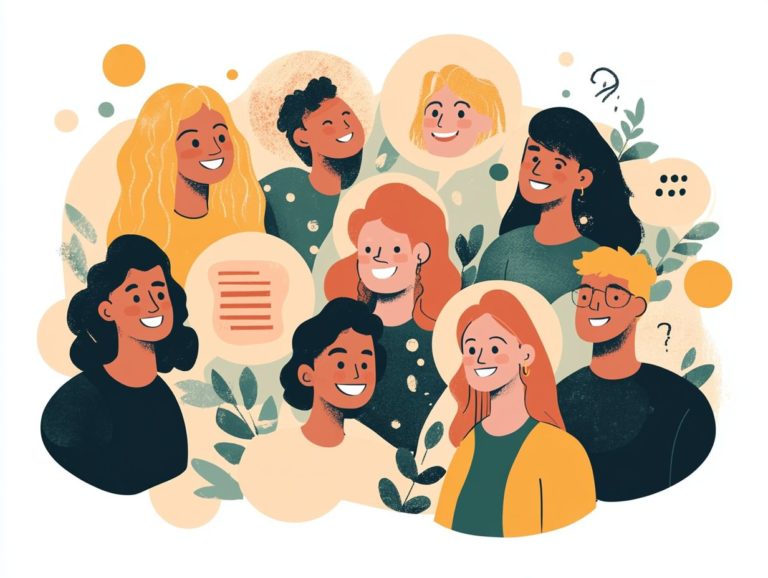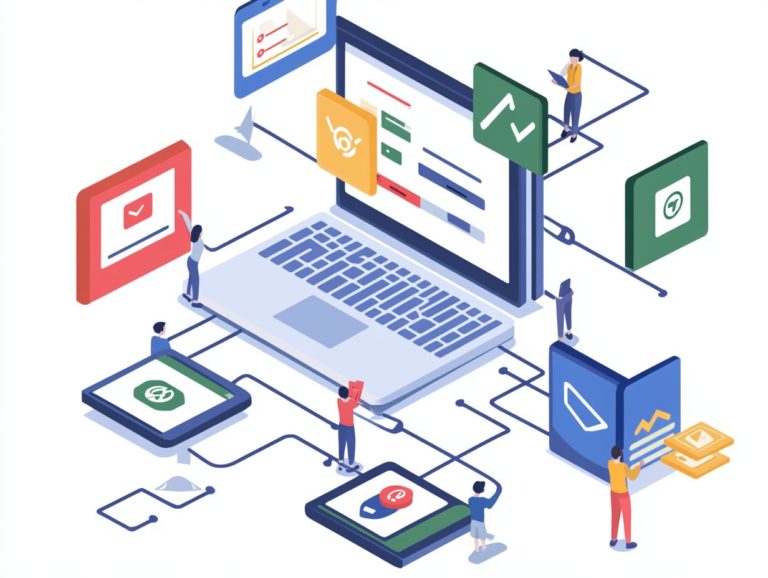How to Use Gamification for Increased Engagement
In today s fast-paced digital world, gamification is becoming an invaluable tool for elevating engagement and motivation across various sectors.
By weaving game-like elements into non-game contexts, you can transform mundane tasks into captivating challenges that truly resonate with users.
This article delves into what gamification really means and its numerous benefits. You ll also discover practical strategies for successful implementation, along with the key elements that drive engagement.
It also highlights common pitfalls to steer clear of and offers metrics for measuring success, ensuring you fully harness the potential of gamification.
Contents
- Key Takeaways:
- Gamification: Definition and Benefits
- Key Elements of Gamification
- Implementing Gamification in Business
- Measuring the Success of Gamification
- Common Mistakes to Avoid in Gamification
- Frequently Asked Questions
- What is gamification and how can it increase engagement?
- How can I incorporate gamification into my business or organization?
- Are there any specific tools or platforms I can use for gamification?
- Can gamification be used for employee engagement and productivity?
- Is it necessary to have a deep understanding of gaming to use gamification effectively?
- How do I measure the success of my gamification efforts?
Key Takeaways:

- Gamification brings game-like fun to everyday tasks, driving engagement and motivation.
- Effective gamification involves a balance of game elements, player motivation, and a clear implementation strategy using suitable tools.
- To measure the success of gamification, businesses should track metrics such as engagement and ROI, while being aware of common mistakes to avoid in the implementation process.
Gamification: Definition and Benefits
Gamification involves applying game elements in non-game settings to elevate engagement, boost employee motivation, and ultimately achieve business objectives. By harnessing components like competition, rewards, and social sharing, you can nurture both employee and customer engagement.
This approach can lead to enhanced productivity, improved retention rates, and greater profitability. Research from Deloitte reveals that gamification effectively taps into our innate desires for feelings of happiness and satisfaction, which motivate people to engage, fostering both intrinsic and extrinsic motivation across various business environments.
Understanding the Concept of Gamification
Understanding gamification means grasping its essential components, which include game elements, user interactions, and the psychological motivators that drive engagement, such as feelings of happiness and satisfaction.
These elements work together to turn mundane tasks into captivating experiences. At its core, gamification leverages psychological theories, particularly Deci and Ryan’s Self-Determination Theory. This theory highlights the importance of intrinsic motivation, suggesting that you re more engaged when you feel a sense of autonomy, competence, and relatedness.
By skillfully integrating these aspects into design, creators can cultivate environments where you not only participate but truly thrive. Recognizing the delicate balance between intrinsic rewards like personal satisfaction and extrinsic incentives, such as points or badges, is vital for developing strategies that resonate profoundly with you.
Advantages of Implementing Gamification
Implementing gamification in your business can unlock a wealth of advantages. These include heightened employee and customer engagement, boosted productivity, and improved retention rates.
Studies from reputable sources like Deloitte and Gallup indicate that organizations embracing gamification experience a notable rise in employee engagement, often translating to greater job satisfaction and stronger loyalty to the organization.
Consider companies like Nike, which have seamlessly woven gamified elements into their training programs, encouraging employees to achieve specific goals through interactive challenges. Dell also exemplifies this approach by incorporating gamification into its recruitment process, resulting in increased candidate engagement and a deeper sense of community.
These successful strategies not only spark employee motivation but also enhance retention and profitability. Gamification is a compelling choice for businesses aiming to flourish in a competitive landscape!
Key Elements of Gamification
Key elements of gamification encompass a range of game elements crafted to elevate player motivation, stimulate engagement, and cultivate a competitive spirit. This is achieved through meticulously structured rewards and feedback systems that keep participants invested and eager to progress.
Discover how gamification can transform your business today!
Game Mechanics and Dynamics

Game mechanics are all about employing various ways to engage, such as rewards, competition, and organized feedback, to stimulate participation and a sense of achievement.
You can seamlessly weave these elements into your business scenarios to craft an immersive experience for both employees and customers! For instance, consider implementing a points system for task completion. This can truly incentivize productivity in the workplace.
A leaderboard that shows top performers fosters competition and achievement.
Organized feedback through regular updates keeps you engaged by offering real-time insights into performance. These mechanics enhance motivation by creating a feeling of pleasure, resulting in a vibrant environment where individuals are eager to participate.
This approach boosts collaboration and cultivates greater customer loyalty, making it a win-win for everyone involved.
Player Motivation and Engagement
Player motivation in gamification hinges on your understanding of both intrinsic and extrinsic motivations, which significantly influence engagement levels and the overall success of games designed to engage users.
Intrinsic motivation is the internal drive you feel when you seek enjoyment and satisfaction from the activity itself. Think about the joy that comes from solving a challenging puzzle or mastering a new skill.
Conversely, extrinsic motivation revolves around external rewards that reinforce behavior, such as earning points, badges, or receiving recognition within a community.
Imagine a well-designed gamified system that incorporates leaderboards to stoke competition, tapping into your extrinsic motivations, while also offering the intrinsic satisfaction of completing levels or accomplishing quests.
Feedback is crucial in this ecosystem, providing valuable insights about your progress and achievements. This fosters a deeper sense of engagement and keeps you motivated to participate actively.
Implementing Gamification in Business
Implementing gamification in your business entails the strategic application of diverse tools and techniques aimed at enhancing employee engagement and fostering customer loyalty, all while aligning with your specific business objectives.
Strategies and Tools for Successful Implementation
Successful implementation of gamification hinges on a variety of engagement strategies and tools specifically designed to meet the unique needs of both employees and customers.
By utilizing platforms like Bunchball and Gamify, you can craft interactive experiences that encourage participation and motivate individuals through rewarding systems. These tools often integrate features such as progress tracking, leaderboards, and challenges.
This not only boosts motivation but also cultivates a spirit of healthy competition among team members.
Take, for example, a well-known retail company that leveraged gamification software for employee training, resulting in an impressive 30% increase in sales productivity.
Similarly, you can enhance customer engagement through apps that reward frequent purchases with points or badges, ultimately leading to higher retention rates and increased customer satisfaction.
Measuring the Success of Gamification
Measuring the success of gamification initiatives is crucial for grasping their impact on engagement and assessing the return on investment (ROI) tied to these strategies.
By evaluating these metrics, you can gain valuable insights into how effectively gamification enhances user interaction and contributes to your overall goals.
Start implementing gamification today and watch your engagement soar!
Metrics for Tracking Engagement and ROI

Key metrics for tracking engagement and ROI in gamification include user growth, participation rates, satisfaction scores, and retention metrics.
By closely monitoring these indicators, you can gain insights into how users behave and the overall effectiveness of your gamification strategies. Tracking user growth over specific periods helps identify patterns and trends that signify your program’s success.
Participation rates reveal how actively users engage with the gamified elements. Satisfaction scores provide essential feedback on their experience.
Analyzing retention metrics shows how well your initiatives keep users engaged over time. This is crucial for understanding their long-term impact and value. Utilizing data analysis tools and surveys allows you to collect this data efficiently, making it easier to evaluate the return on investment (ROI) associated with your gamification efforts.
Common Mistakes to Avoid in Gamification
When implementing gamification, you may encounter common mistakes that undermine your engagement strategies and detract from the user experience. Planning carefully is key to success!
Identifying and Addressing Potential Pitfalls
Identifying and addressing potential pitfalls in your gamification initiatives is essential for maximizing engagement and ensuring a truly positive user experience.
You may face challenges like unclear objectives, which can leave users feeling confused, or inadequate onboarding processes that don t prepare participants for the gamified environment.
To overcome these hurdles, outline specific, measurable goals from the very beginning. Establishing clear metrics will guide your initiative and provide users with a sense of direction.
Implementing a comprehensive onboarding strategy that helps users become familiar with the system is key. By incorporating tutorials and offering instant feedback, you can help users feel more comfortable and engaged, leading to a more successful gamification experience.
Frequently Asked Questions
What is gamification and how can it increase engagement?
Gamification is the use of game-like elements, such as points, rewards, and challenges, in non-game contexts. It increases engagement by making tasks more fun and rewarding, encouraging users to continue participating.
How can I incorporate gamification into my business or organization?

There are various ways to use gamification for increased engagement:
- Create a point system for completing tasks
- Offer rewards for achieving certain goals
- Implement leaderboards to encourage friendly competition
Are there any specific tools or platforms I can use for gamification?
Yes, many gamification platforms and tools make it easy to incorporate game-like elements into your business or organization. Some popular options include:
- Bunchball
- Badgeville
- Gamify
Can gamification be used for employee engagement and productivity?
Absolutely! Many businesses have successfully used gamification to increase employee engagement and productivity. By setting up challenges and rewards for completing tasks, employees are motivated to work harder and more efficiently.
Is it necessary to have a deep understanding of gaming to use gamification effectively?
No, you do not need to be a gaming expert to use gamification for increased engagement. However, it is important to understand your target audience and what motivates them to design effective gamified experiences.
How do I measure the success of my gamification efforts?
You can measure the success of your gamification efforts using various metrics, such as user participation rates, task completion rates, and user feedback. You must track these metrics consistently to improve your gamification strategy!
Consider reaching out for assistance or additional resources to implement gamification strategies effectively.






